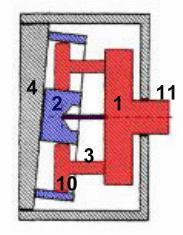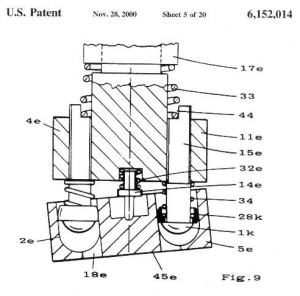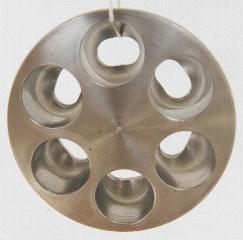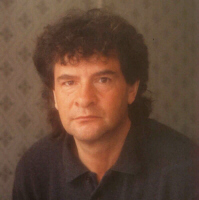
Revolutionary rotary piston machines
for pumps, compressors, motors with new work processes.
A fundamental breakthrough in the design of piston machines with
the simplest but most powerful piston actuating mechanism ever created.
Six screws, with sealing elements function as pistons, are screwed on a plate/shaft being one solid piece without any connecting bearings between pistons and drive shaft.
Summary:
New pumps, compressors, water hydraulic motors are introduced - based on the Wolfhart Principle - a new rotary piston machine combined with new
work-processes.
The physicist and inventor Wolfhart Willimczik created a rotary piston machine without any bearings in the power train and with only rotating pistons.
A stroke motion without mass forces is finally realized! Friction is eliminated or drastically minimized respectively that such machines are able to
run a priori without any lubrication - even at high pressure. It is the ideal machine for many applications.

Video 1.4
A Pump (2GPM at1000PSI) running in the work shop of the inventor.
Compare the sound of this pump with the one of a formula one racing car; it is the same frequency. (6 pistons at 3400rpm sounds
like 6x 3400rpm=20400rpm) You hear the fastest piston pump letting all others on the market far behind.
The reason lies in the better kinematic of this pump. In contrast to common water piston pumps
with valves the fluid runs continuously through the pump in a circular orbit and the velocity will never be zero with reversing the direction.
The secret of the first bearing-less, pulling, self aligning piston actuating mechanism


1 - Piston Rotor/Plate ....2 - Cylinder Rotor/Block ....3 - Piston Rod/Screw .....4 - Carbon Control Plate
5 - End Plate .... 6/7 - In/Outlet ....8 - Mechanical Shaft Seal.....9 - Electrical Motor....10 - piston....11 - shaft

6 spherical pistons and the cylinders rotate with an angle at 5° to each other.
To see is here the pressure side, where the pistons do not work. (the cylinders are cut open.
More Videos of the Wolfhart Principle
Basic principle:
The aligned rotation of pistons and cylinders at a small angle generates a relative stroke motion between them in the co-rotating reference system. The pistons, passing over the inlet port, suck in and push to the same time backwards against the high working pressure in the housing. Pistons and cylinders only rotate and are counterbalanced. There are no mass forces. Piston rods, piston plate, and drive shaft are one solid piece without any bearings between them. Hydraulic forces are all hydraulically compensated.
This principle is an axial piston type - similar to a Bent Axis Pump, but only at first
glance.
In this pump, the cylinder are at a small angle (5°) to the drive shaft and Piston Rotor/Plate.
The connecting rods are screwed on the Piston Rotor/Plate.
The drive shaft, piston plate/rotor (with the pistons), and cylinder block/rotor all revolve.
The cylinder block/rotor has no own shaft. It is guided by the pistons.
The pistons (mostly spherical) are swing able in the cylinders.
The in/outlet ports are semi-circular holes in the Valve Plate.
A short stroke motion and large pistons are characteristic for this design.
In this version, the connecting rods only pull the pistons against the high pressure in the housing.
The pistons must be (are) pressure tight only in one direction and only half the revolution.
Characteristic features
No bearings in the piston actuating mechanism:
The most significant difference to all other piston machines is the absence of any bearing in the power train (between the pistons and a drive shaft).
Piston forces are transformed in a torque without using a single bearing transmitting piston forces. Therefore, the pistons can be enlarged to any
size at any pressure. Piston forces are not more restricted by the limitations of bearings. (The drive shaft is axially balanced.) Kinematic and work
process are unique: A bearing-less piston actuating mechanism with only rotating pistons generates a relative stroke motion between pistons and
cylinders without mass forces normally belonging to it. It is the best kinematic possible. The pistons, passing over the inlet port, suck in and push
to the same time backwards against the high working pressure in the housing. That`s basically the entire pump-process. On the other half of one
revolution the pistons have nothing to do anymore. They could be taken out for this time period. (They are not air-tight in this phase.) All what they
do is moving in the start position for the next working phase. This new work process has numerous dramatic consequences. Piston forces can be
totally balanced. Furthermore, the "compression phase" in the cylinder is eliminated, that means a fluid-gas mixture can be pumped -
even against high pressure. Gas can be compressed almost as high as fluid pressure. Most complete balance of all forces: Oscillating mass forces are
not present. Both rotors revolve around the centers of gravity. The cylinder block is hydraulically balanced by funneling high pressure under the
cylinders which are partially closed for this purpose. The drive shaft, piston plate, and pistons are one piece and are axially balanced by making the
area content of the cross section of the drive shaft (on the shaft seal) equal to the sum of all active piston areas. The hydraulic forces on the
pistons and on the drive shaft compensate each other in axial direction, because the pistons are pushing backwards. Total oil-free operation for
pumps, compressors, water hydraulic motors etc. Friction is dramatically minimized that this rotary piston machine is able to run without any
lubrication - even at high pressure, high volume and high speed. Largest range in volume and pressure: The Wolfhart Principle has no limitations in
the possible range of volume and pressure. The product "volume times pressure" is the highest. There are principles for high volume and
others for high pressure; this principle can both at the same time. A typical application may a water pump for 1000 GPM at 1000 PSI, where no other
principle is suitable.
Largest range of speed:
Some principles must run with a minimum speed, some are not able to run fast. This principle can both. The kinematic of this machine has no
limitations. (The maximal speed will determined by other parameters like the viscosity of the medium etc.)
Highest possible efficiency:
Low friction, low acceleration of the fluid, and large ports etc are the means for a smooth operation and a high efficiency. The tests show that this
new principle has the highest possible efficiency. (Test data are available.)
No lateral forces between pistons and cylinders:
The connecting rods are screwed on the piston plate with an specific angle that in the working
phase of the stroke motion the connecting rods are straitened in the cylinders and lateral forces
minimized. A certain overcompensation drives the cylinder block. That means the cylinder
rotor is hydraulically driven.
Highest possible durability:
Simplicity breeds Durability. This simplest piston principle has also the highest durability.
If foreign particles are coming in, the cylinder block is able to lift up from the valve plate. The
piston sealing elements are also hold in place only by a spring. They can actually stop moving
in the cylinders until the particle is gone.
If one connecting rod should break, the piston remains on the ground of the cylinder and the
pump is still running generating pressure.
High live expectancy:
No bearing is better than the best bearing. If the piston plate is directly attached to the shaft of an electrical motor, the entire pump has no
bearing. The remaining wear on cylinder block and pistons is minimized by eliminating of unnecessary contact pressure.
The cylinder block is hydraulically adjusted for a minimum of contact pressure.
The spring-load of the piston rings is about 10 times lower compared with conventional piston pumps allowing a small leakage, but a much greater live
span.
Disadvantages of this new principle:
It is unknown and not on the market
To the theory:
The inventor found by an mathematical analysis a "magic angle" of 5° for the inclination angle between both rotors
which opens up enough volume, while the distortions, caused by the inclination angle, are still insignificant. This is
the base of this invention.
The latest Wolfhart Pump
A total oil-free water pump for 1-10 GPM (adjustable as option), 500 to 4000 rpm at 1000 PSI to 2000PSI
& the first clear water hydraulic motor



The piston rotor with the shaft.....................................................The cylinder rotor
Pistons, piston plate, and drive shaft are one piece.
Both parts are hydraulically balanced and don't need any lubrication - even at high pressure.

These are all moveable parts of the Wolfhart Pump
This is not the only one. The possibilities are endless...
Some rotors (volumes: about 1L/min left, 50 GPM and 1CFM on the right.)
Links to my other developments:
http://www.WolfhartIndustries.com
the ideal principle for the water hydraulic and reverse osmosis
the ideal pump for waterworks and the smallest Wolfhart pump
the ideal principle for oil-free compressors at high pressure
tests of the latest Wolfhart pump
other Wolfhart rotary piston technologies
Environmental friendly two stroke engine
Rotary linear generator (stroke-rotor generator)
A new blowout preventer (BOP) for the oil industry to prevent oil spills
Theory for cause of metastable state
Solution for the energy problem on earth: ultra deep geothermal power plant
Publications:
My US-Patent 6,152,014
My invention in "World Pumps"
My patents and other publications
Links to Wolfhart technologies:
http://www.allstar.fiu.edu/aero/WOLFHART.htm
http://www.animatedsoftware.com/pumpglos/wolfhart.htm

The Physicist and Inventor Wolfhart Willimczik
Wolfhart@tampabay.rr.com
©2010 All rights reserved